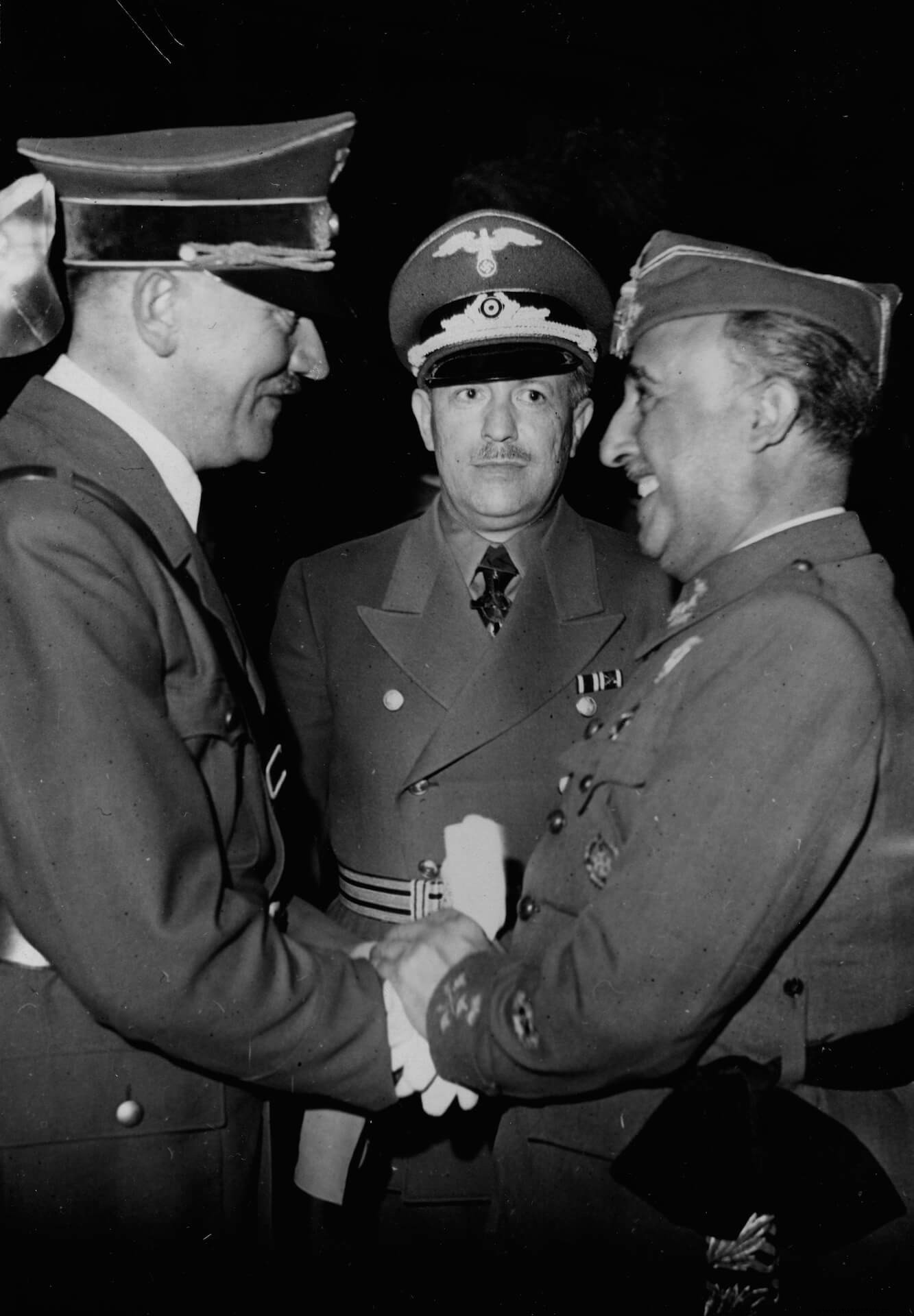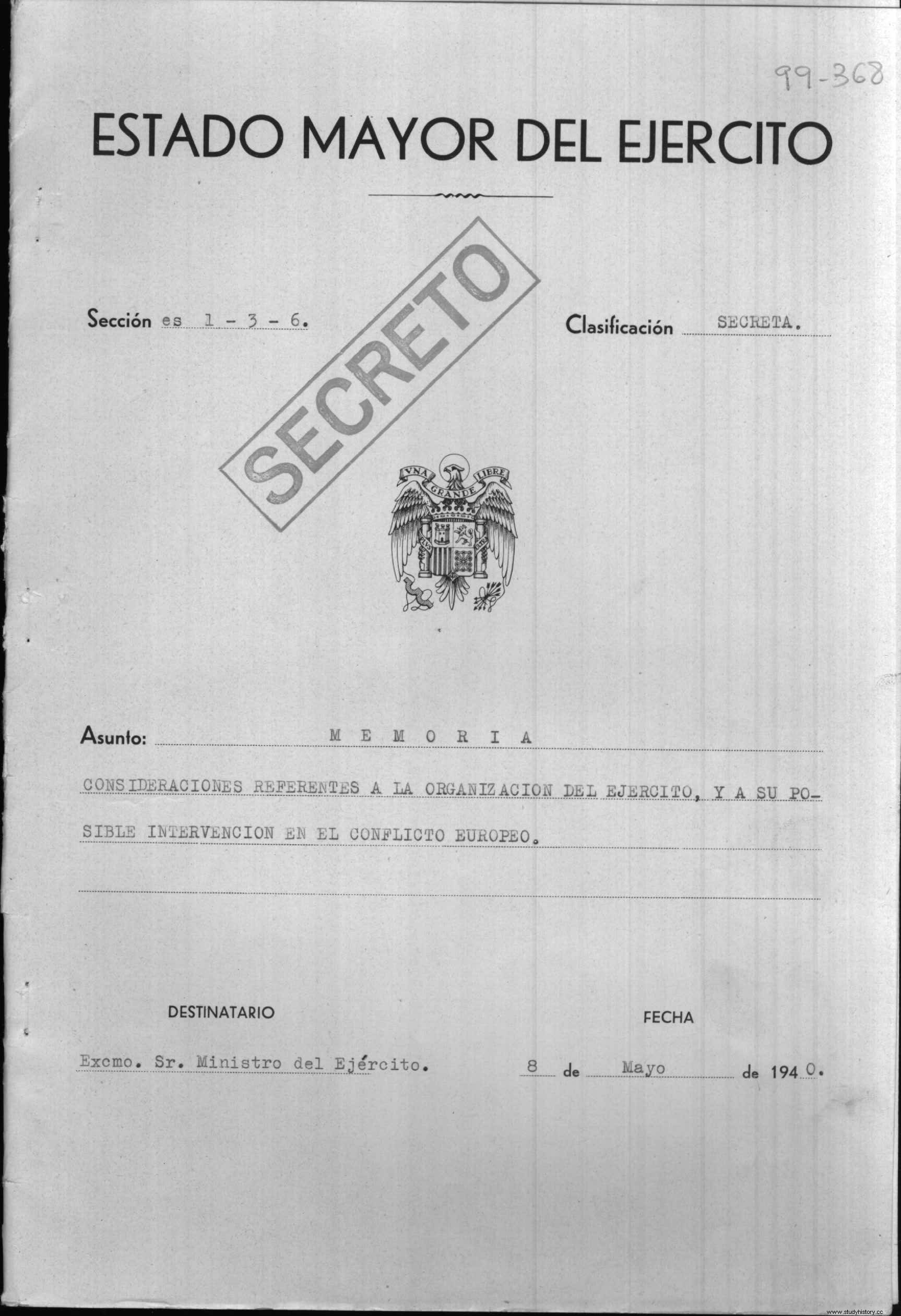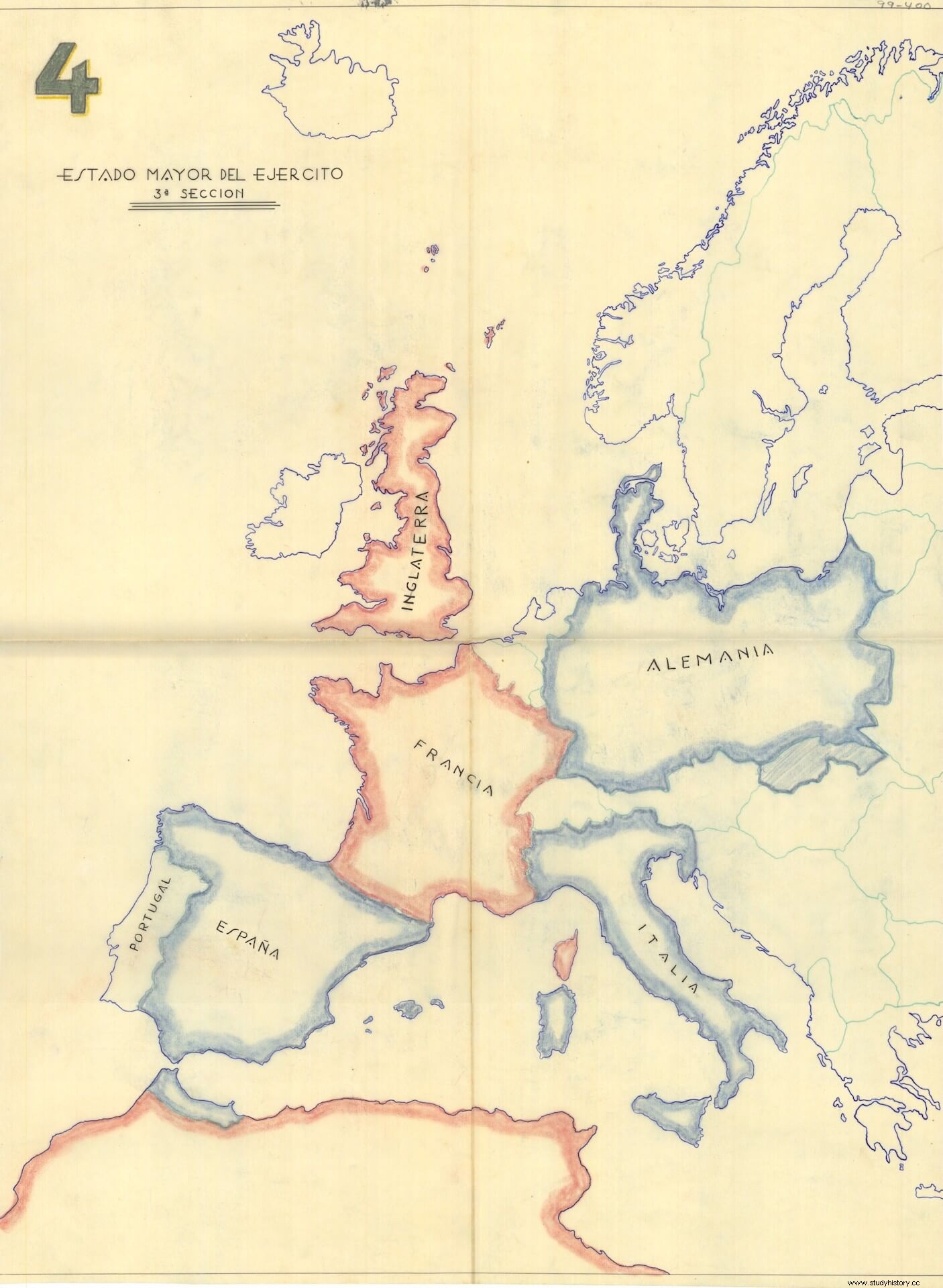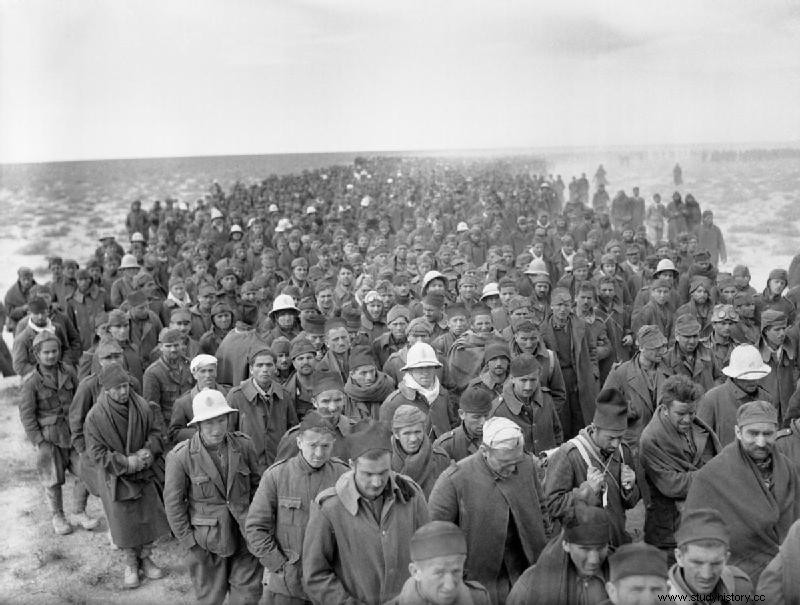
The May 8 report by Martínez Campos
When the Civil War ended, the Nationalist Army became what the regime called the "Army of Peace", reducing its size from an equivalent of about 57 divisions to 25. In April 1940 the reorganization of the Spanish divisions was completed. The authorities of the regime, mainly the Falangists, wanted Spain to recover its imperial projection and to do so join the Axis powers in the war, occupying the position at the table of the victors that they believed was theirs.
The military authorities were much more cautious regarding the participation of the Spanish Army during World War II. The first to warn of the poor situation of the troops was General Kindelán, who, already in September 1939, through confidential reports, warned of the inability to defend the Balearic Islands in the event of a coup de force by the Italians or the French.

On May 8, 1940, just two days before the German invasion of France began, the head of the EME, General Martínez Campos, presented a top secret report to the Minister of the Army, General Varela, entitled Considerations regarding the organization of the Army and its possible intervention in the European conflict . The memory consists of 27 pages and is divided into four large chapters:operations, organization and mobilization, weapons and material, and final considerations. On the second page of the report, he shows his negative opinion of participation in the war:“Spain, after a three-year war of attrition, is too weak to intervene, on one side as well as on the other, and it would be better for him, at all costs, to be neutral ”. (Underlining is ours)
Although Martínez Campos acknowledged in the report that some gratitude was due to Germany for the help provided during the Spanish War and for the ideological affinity, he also pointed out that it did not signing a pact with the USSR in August 1939 or that Mussolini's Italy remained neutral and awaiting the evolution of the war in May 1940 had mattered. Furthermore, after the invasion of Denmark and Norway it did not seem that the great powers were to be willing to respect neutral nations, in fact only two days after submitting this report Germany invaded neutral Belgium, Holland and Luxembourg. So, in his opinion, when Italy decided on which side to participate in the war, it would be the most dangerous moment for Spain, since it would break the status quo of the Mediterranean so that some of the powers could intervene either in the Balearic Islands, which had already been the base of Italian operations during the Civil War, or in the Protectorate of Morocco, where a French intervention would mean the definitive closure of the Strait, with what that Spain would be forced to defend its territory. The development of the war in Europe was punctually sent to Madrid by the military attaches of the Spanish embassies in classified files and until now buried and inaccessible in the military archives.
The Balearic Islands They would be during the first months of 1940 one of the greatest military concerns for the regime, since the general commander of the islands, General Kindelán, considered that the powers could take control of it through a landing or a "courtesy visit", that is that is to say, the friendly scale of a strong naval squadron that later raised an ultimatum. In anticipation of any of these eventualities, Kindelán warned of the need to protect the archipelago by increasing the units deployed, carrying out fortification works or reinforcing the coastal artillery, among other things. Another center of attention on the part of the EME was the Protectorate of Morocco where the best units of the Army were stationed, in addition its regiments were reinforced and the High Commissioner in Morocco, General Carlos Asensio Cabanillas and later his successor, General Luis Orgaz, traced defense plans in case of French intervention.

In his report, Martínez Campos valued the importance from the border of the Pyrenees, especially in case of intervening on the Axis side, as well as from the Canary Islands, the colony of Guinea or the naval bases and the defense of the coast. In addition, several options were analyzed weighing both the possibility of Spain intervening on the Axis side and on that of the Allies. Away from political considerations, he judged that the best thing that could happen to Spain is for Italy and Portugal to intervene on the allied side, which would allow them to be neutral, although under the circumstances it did not seem the most feasible, and if that did not happen it was much better, from a strictly military point of view, to intervene on the allied side.
Also, in his opinion, it would be most likely that Italy would go to war together with Germany, which did not force Spain to declare war, as it finally happened, except that an allied invasion of some of the Spanish territories forced them to do so. That was considered the worst scenario and it would get even worse if Portugal decided to join the allied side.
In the event that Spain was dragged into war, Martínez Campos proposed four specific points in anticipation of such a circumstance:put the divisions with their troops on a war footing, intensify instruction, plan a total mobilization and warn the military commanders that any foreign unit detected on Spanish soil would be immediately considered as an enemy. Martínez Campos accompanied his report with a series of detailed data on the situation of personnel, weapons, supplies and a whole series of technical details. The analysis of these reaffirmed the need for Spain to remain neutral, allowing himself to suggest that “extraordinary prudence should be followed everywhere and in all hierarchies ” (The underlining is from General Varela)
The Fall of France
The French collapse in June surprised the Spanish military as unexpected, although they did not hide a certain sympathy for the German victories, which made the proximity between the two countries increase, especially after the appointment, in October 1940, of Serrano Suñer as Minister of Foreign Affairs. During the summer of that year, contacts had already taken place between General Vigón, chief of the High General Staff (AEM), and Hitler himself to coordinate a Spanish-German intervention with a view to occupying the Rock of Gibraltar.
In June 1940, at a meeting of the AEM to discuss the situation of the Army's weapons and material, Franco himself wrote in his own handwriting “What can Germany give us? ”. So, when Franco met with Hitler in Hendaye to discuss the conditions under which Spain would enter the war on the Axis side, the Generalissimo was perfectly aware of the exact situation of the Army thanks to the secret and reserved information written by the EME and the General Directorates of the military ministries, which was subsequently dealt with in periodic meetings of the AEM.
The non-intervention of the Spanish Army during World War II
What was agreed in Hendaye has been widely discussed in the bibliography and could be briefly summarized in that Germany would provide the necessary supplies to Spain to enter the war whose first objective would be the taking of Gibraltar (Operation Felix ), and a future territorial expansion to be determined later. Spain, for its part, would cede naval bases to Germany, and the German side even requested the complete cession of one of the Canary Islands. It was still pending to determine the amount of the aid to be received by Spain, the economic cost of the same, as well as the moment in which it would be delivered.

Mobilization plans were drawn up in Spain in November 1940 and the following month, in December, campaign plan number 34 would be born, a project for the invasion of Portugal if necessary. However, none of this ever materialized. The situation in the Mediterranean worsened for the Italians with resounding defeats, both on land (Beda Fromm in February 1941) and at sea (the Battle of Cape Matapán in March 1941). The failure of Italian intervention in Greece and the coup in Yugoslavia made the Germans turn their eyes towards the eastern Mediterranean, losing more and more interest in using the resources requested by Spain to participate in the war.
In June 1941, when the Germans unleashed Barbarossa , the axis of the Second World War was moving inexorably to the east, all the resources were necessary in such a large theater of operations, so the plans to occupy Gibraltar were falling into oblivion.
The lack of resources and qualified personnel of the Spanish Army worsened over the years, as evidenced by the monthly and secret reports of the Second Section bis of the EME, the one in charge of intelligence work. Despite some purchases made through the Bär plan, barely twenty Panzer IVs in the armored chapter, and the pressure from the Falangists in favor of intervention, the Spanish Generalate was convinced that without German help this would be impossible. German defeats against Moscow and the later in Stalingrad they convinced these of the impossibility of the Axis winning the war. So, when in November 1942, the Anglo-Americans launched Operation Torch the high echelons of the Spanish Army preferred to forget about a possible intervention in the war, aware of their inferiority with respect to the nations at war.
For more information on the Spanish Army during World War II, we invite you to visit this thread on the El Gran Capitán military history forum.
Fonts
Ávila Military Historical Archive
Personal File of General José Enrique Varela
Francisco Franco Foundation Archive
Archive of the Institute of Military History and Culture of Madrid
